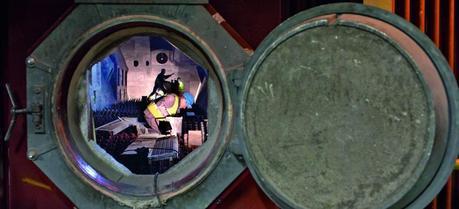 A wood pellet-fired boiler under construction at the Połaniec biomass power station in Southeast Poland, July 2012. (Credit: Flickr @ Bilfinger SE http://www.flickr.com/photos/bilfinger/)
A wood pellet-fired boiler under construction at the Połaniec biomass power station in Southeast Poland, July 2012. (Credit: Flickr @ Bilfinger SE http://www.flickr.com/photos/bilfinger/)European power plants that burn wood pellets imported from the Southern United States to generate electricity are emitting less than half the greenhouse gases than when they use traditional fossil fuels, a new University of Georgia study has found.
European power utilities are using imported wood pellets to generate electricity and reduce greenhouse gases in order to meet a legal mandate that by 2020 at least 20% of all energy consumed in the European Union comes from renewable sources. A new study by a researcher with UGA’s Warnell School of Forestry and Natural Resources has found that the wood pellets are living up to their promise of releasing fewer greenhouse gases-producing less than half the greenhouse gas emissions than when power plants use fossil fuels such as coal and natural gas. This is good news for the Southern United States, which is a leading exporter of wood pellets to Europe, said Puneet Dwivedi, an assistant professor of sustainability sciences in the Warnell School.
Environmental Research Letters recently published these findings. Dwivedi studied the greenhouse gas emissions in the United Kingdom, which has a target of increasing to 15 percent the amount of energy consumed from renewable sources by 2020. These renewable sources include energy products derived from woody feedstock such as wood pellets, which are typically made from waste material left over after a tree is harvested or processed for wood manufacturers. Manufacturers in the Southern United States make these pellets by using a process that dries and compresses this leftover material, forming them into small vitamin-shaped capsules.
As the United Kingdom and other European countries implement the mandates, exports of wood pellets from the Southern United States are predicted to increase from 1.5 to 5.2 million metric tons between 2012 and 2015. Dwivedi focused on greenhouse gases emitted at a power plant in Selby, home of the largest coal-fired power plant in the United Kingdom. This power plant recently announced plans to generate about 1,000 megawatts of electricity using imported wood pellets from the Southern United States.
Dwivedi found that the intensity of greenhouse gases emitted for every unit of electricity generated from imported wood pellets is at least 50 percent lower than when using traditional fossil fuels. Even more, Dwivedi said, his study found that as the power plant’s capacity rose, so did the greenhouse gas savings, which means the higher capacity plants would greatly benefit from using wood pellets. Although many European countries use wood pellets to generate power, it is not used in the U.S. because of the cost.
However, the European demand for wood pellets will give a boost to the forest industry in the Southern United States, he said. “Emerging export markets of wood pellets provide an economic opportunity for forestland owners in the Southern United States who have faced significant challenges due to the housing market collapse and the decline of the paper industry,” Dwivedi said.
Puneet Dwivedi, Madhu Khanna, Robert Bailis and Adrian Ghilardi (2014). Potential greenhouse gas benefits of transatlantic wood pellet trade Environmental Research Letters, 9 (2) DOI: 10.1088/1748-9326/9/2/024007
